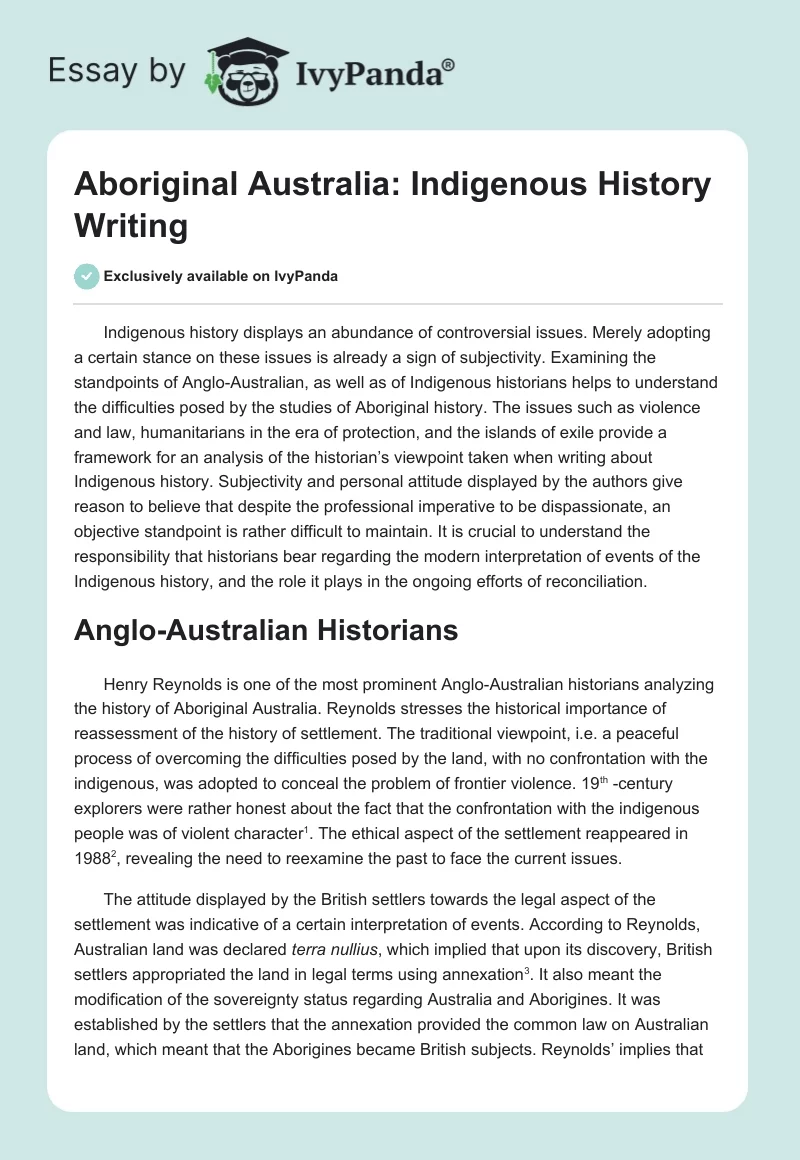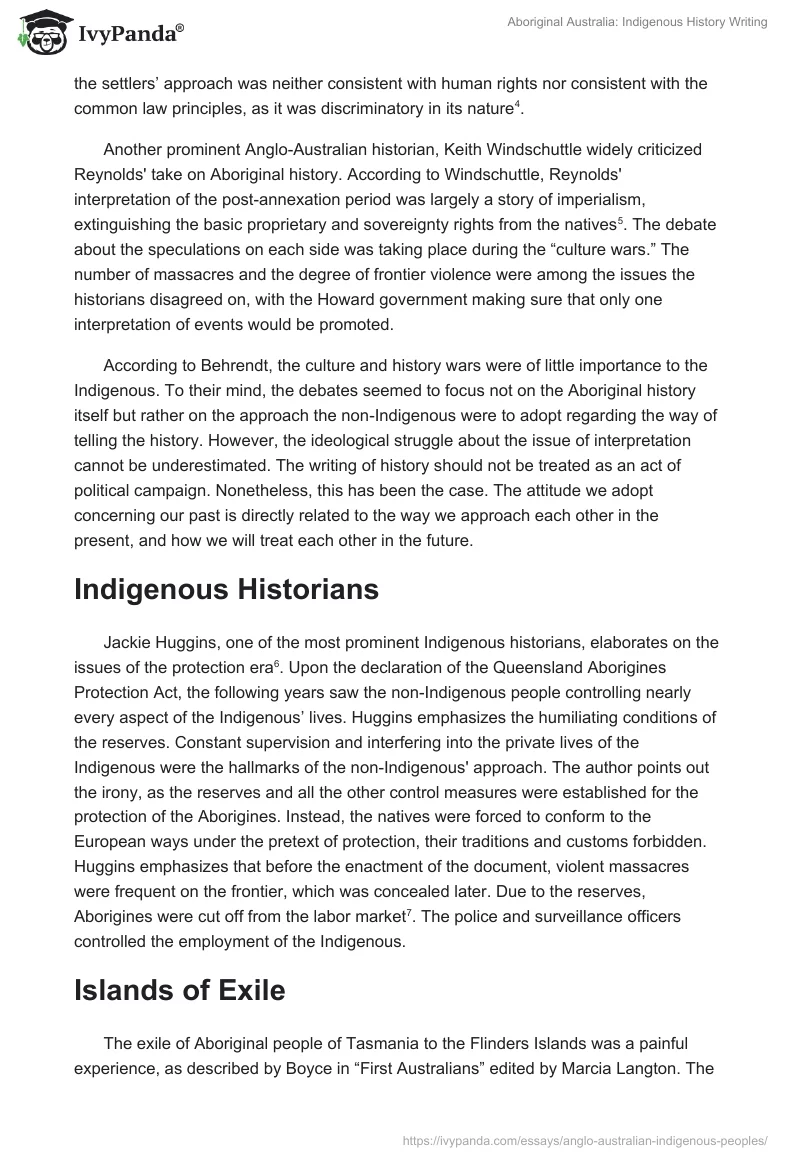Indigenous history displays an abundance of controversial issues. Merely adopting a certain stance on these issues is already a sign of subjectivity. Examining the standpoints of Anglo-Australian, as well as of Indigenous historians helps to understand the difficulties posed by the studies of Aboriginal history. The issues such as violence and law, humanitarians in the era of protection, and the islands of exile provide a framework for an analysis of the historian’s viewpoint taken when writing about Indigenous history. Subjectivity and personal attitude displayed by the authors give reason to believe that despite the professional imperative to be dispassionate, an objective standpoint is rather difficult to maintain. It is crucial to understand the responsibility that historians bear regarding the modern interpretation of events of the Indigenous history, and the role it plays in the ongoing efforts of reconciliation.
Anglo-Australian Historians
Henry Reynolds is one of the most prominent Anglo-Australian historians analyzing the history of Aboriginal Australia. Reynolds stresses the historical importance of reassessment of the history of settlement. The traditional viewpoint, i.e. a peaceful process of overcoming the difficulties posed by the land, with no confrontation with the indigenous, was adopted to conceal the problem of frontier violence. 19th-century explorers were rather honest about the fact that the confrontation with the indigenous people was of violent character. The ethical aspect of the settlement reappeared in 1988, revealing the need to reexamine the past to face the current issues.
The attitude displayed by the British settlers towards the legal aspect of the settlement was indicative of a certain interpretation of events. According to Reynolds, Australian land was declared terra nullius, which implied that upon its discovery, British settlers appropriated the land in legal terms using annexation. It also meant the modification of the sovereignty status regarding Australia and Aborigines. It was established by the settlers that the annexation provided the common law on Australian land, which meant that the Aborigines became British subjects. Reynolds implies that the settlers’ approach was neither consistent with human rights nor consistent with the common law principles, as it was discriminatory in its nature.
Another prominent Anglo-Australian historian, Keith Windschuttle widely criticized Reynolds’ take on Aboriginal history. According to Windschuttle, Reynolds’ interpretation of the post-annexation period was largely a story of imperialism, extinguishing the basic proprietary and sovereignty rights from the natives. The debate about the speculations on each side was taking place during the “culture wars.” The number of massacres and the degree of frontier violence were among the issues the historians disagreed on, with the Howard government making sure that only one interpretation of events would be promoted.
According to Behrendt, the culture and history wars were of little importance to the Indigenous. To their mind, the debates seemed to focus not on the Aboriginal history itself but rather on the approach the non-Indigenous were to adopt regarding the way of telling the history. However, the ideological struggle about the issue of interpretation cannot be underestimated. The writing of history should not be treated as an act of political campaign. Nonetheless, this has been the case. The attitude we adopt concerning our past is directly related to the way we approach each other in the present, and how we will treat each other in the future.
Indigenous Historians
Jackie Huggins, one of the most prominent Indigenous historians, elaborates on the issues of the protection era. Upon the declaration of the Queensland Aborigines Protection Act, the following years saw the non-Indigenous people controlling nearly every aspect of the Indigenous lives. Huggins emphasizes the humiliating conditions of the reserves. Constant supervision and interference into the private lives of the Indigenous were the hallmarks of the non-Indigenous approach. The author points out the irony, as the reserves and all the other control measures were established for the protection of the Aborigines. Instead, the natives were forced to conform to the European ways under the pretext of protection, their traditions and customs forbidden. Huggins emphasizes that before the enactment of the document, violent massacres were frequent on the frontier, which was concealed later. Due to the reserves, Aborigines were cut off from the labour market. The police and surveillance officers controlled the employment of the Indigenous.
Islands of Exile
The exile of Aboriginal people of Tasmania to the Flinders Islands was a painful experience, as described by Boyce in “First Australians” edited by Marcia Langton. The author indicates the incredibly high death rate from the disease among the Indigenous living there. Despite that fact, they had not been allowed to go to the mainland for a long time, as the government saw them as a threat to the balance of local economy, including land prices.
The Missionaries
Christian missions were introduced as an extension of the government policy, and education was provided for the Indigenous. Eventually, the missionaries obtained sufficient power to intervene in the lives of Aborigines, and even exercise a certain degree of control. John Harris, an Australian historian, elaborates on these events, emphasizing that the missionaries could not often separate the Christian teachings and the “European civilization”. They adopted a dominant attitude towards the Indigenous, and often “arrogant, rather than humble”.
Harris justifies their approach by explaining that the superiority of European civilization was a common viewpoint at the time. The humanitarians’ mission was to make sure the Indigenous adopted the culture brought by the settlers. Whether any explanation can justify an approach designed to control other people’s lives is not an open question anymore. Justifications of such an attitude can have grave implications, especially for the non-Indigenous people, regarding their current relationship with the Indigenous. However, mitigating the circumstances might increase the possibility of eventual reconciliation.
Bunjilaka Gallery
In an article on the First People Exhibition at the Bunjilaka Gallery at the Melbourne Museum, Witcomb suggests that the collaboration of the Museum with the Indigenous shows promise for the possibility of reconciliation. The author emphasizes the importance of such practices. It is indicative of a willingness to reevaluate the current perception of historical development, as well as alter and rethink the official standpoints on the matter. Witcomb assumes that such projects if undertaken on a wider scale, might significantly improve the relations between the Indigenous and the non-Indigenous population.
Several examples of previous exhibitions are provided, where the diverse cultural approach was employed. Direct integration of Indigenous community members was used, as well as presenting two opposing worldviews: the anthropologist’s outlook (Baldwin Spencer’s) and the worldview of the elder of one of the Indigenous communities. Witcomb indicates the political purposes of these exhibitions. By combining the Indigenous and non-Indigenous worldview, the authors wanted to communicate that the conventions were being rethought and reassessed, and Indigenous diversity was being acknowledged and appreciated.
Conclusion
Overall, the political aspect of writing of indigenous history is very pronounced. Personal aspects also play a decisive role in events interpretation. The debate between Windschuttle and Reynolds demonstrates how critical the stance adopted by a historian can be when it comes to ideological struggle. According to Bongiorno, Keith Windschuttle maintained that the guerilla war, described by Henry Reynolds, is nothing more than criminal actions. As Windschuttle challenges Reynold’s assessment of events related to frontier violence, calling it speculative and dubious, we might be led to think whether altering the widespread perception of the past might improve the Indigenous /non-Indigenous relations, as well as contribute to final reconciliation in the future.
Therefore, historians bear considerable responsibility for the eventual outcome of events such as “culture wars” in Australia. As the debates surrounding the interpretation of past events are strongly tied to the idea of national identity, the subject is rather fragile and requires careful consideration, as well as a thorough reassessment. The way both sides understand their past today will shape the mindset of future generations. While the differences in their worldview cannot disappear, the one thing they have in common is the personal approach, which fuels the ongoing debates.
References
Behrendt, L., Indigenous Australia for dummies. John Wiley & Sons, Sydney, 2012.
Boyce, James., ‘Towlangany: To Tell Lies. ‘What business have you here?’ in R. Perkins, M. Langton, W. Atkinson, & J. Boyce ed., First Australians, Melbourne University Publishing, Melbourne, 2010, pp. 43-77.
Frank B., review of Frontier, Race, Nation: Henry Reynolds and Australian History, Web.
Harris, J., ‘Reconciliation with God and with each other: the Church’s ministry with Indigenous Australians’, 1998, Web.
Harris, J., One Blood: Two hundred years of Aboriginal encounter with Christianity [online facsimile], Concilia LTD, 2013, Web.
Huggins, Rita, and Jackie Huggins. Auntie Rita. Aboriginal Studies Press, Canberra, 1994.
Reynolds, H. Aboriginal sovereignty: Reflections on race, state, and nation. Allen & Unwin, St. Leonards, 1996.
Reynolds, H. Dispossession: Black Australians and white invaders, Allen & Unwin, St. Leonards, 1989.
Witcomb, A., “Look, Listen and Feel”: The First Peoples exhibition at the Bunjilaka Gallery, Melbourne Museum.” La Revue des Musées de la Civilisation, vol. 1, no. 1, 2014, pp. 49-62.


